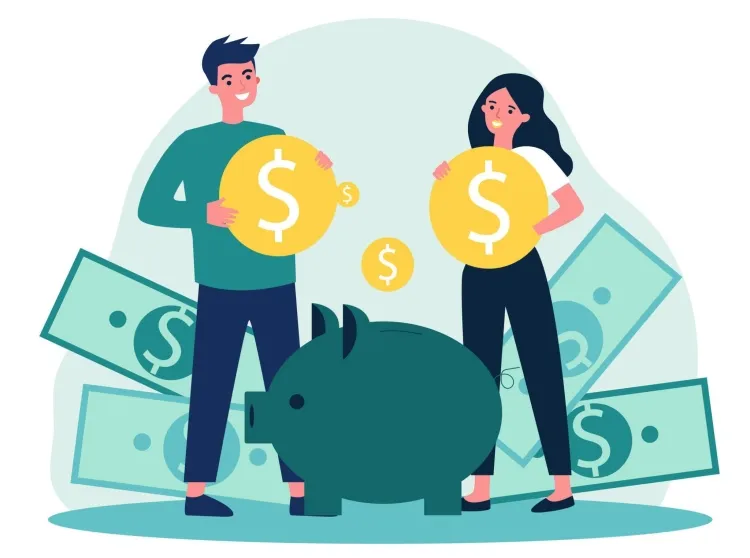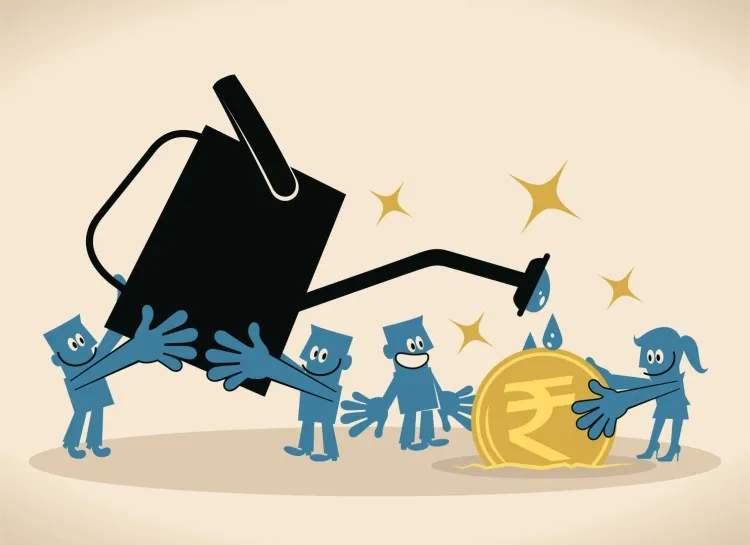10 Habits of Financially Independent People: How to Achieve True Financial Freedom
Achieving financial independence is possible by developing the right habits and mindset. Learn the 7 key habits of financially independent people to take control of your money and gain true financial freedom. Develop a plan to earn, save, and invest your money so you can achieve financial independence and retire early.

Table of Content
Achieving financial independence is a goal that many people strive for, as it offers the freedom to live life on your own terms without being tied to a traditional job. While the path to financial independence can be challenging, there are certain habits and mindsets that successful individuals adopt to reach this milestone. Here are some habits of financially independent people that can help you achieve true financial freedom:
1. Develop a Growth Mindset
Developing a growth mindset is crucial for achieving financial independence. A growth mindset is the belief that abilities and intelligence can be developed through dedication and hard work.
Financially independent people understand that their wealth-building skills and knowledge are not fixed but can be continuously improved. They embrace challenges as opportunities for growth, seek feedback, and are willing to learn from their mistakes. By adopting a growth mindset, they stay curious, adaptable, and open to new strategies and opportunities that can further their financial goals. This mindset helps them overcome setbacks, continuously expand their knowledge, and ultimately achieve greater financial success over time.

1.1 Understand the power of belief
Having a growth mindset is essential for success and well-being. When you believe in the power of growth and development, you open yourself up to new perspectives and opportunities. With hard work and persistence, abilities and intelligence can be developed over time through dedication and effort. When you embrace growth, limitations and failures are temporary rather than permanent. Developing a growth mindset involves recognizing that abilities are malleable rather than fixed, and that efforts and strategies are more impactful than inherent talents.
1.2 Embrace challenges and failures
Individuals with a growth mindset view challenges and failures as opportunities rather than threats. They recognize that failure is often a natural part of progress and learning. With a growth mindset, you believe that abilities can be developed and that skills are built through hard work and practice. Setbacks and failures do not define you, but rather serve as motivation to improve and refine strategies. Each challenge and struggle makes you stronger and smarter. Having a growth mindset means embracing failures and using them as learning opportunities.
2. Create a Financial Vision
Creating a clear financial vision is an essential first step for those seeking financial independence. A financial vision serves as a roadmap, providing direction and motivation throughout the journey. Financially independent people take the time to deeply contemplate their desired lifestyle, values, and long-term goals. They visualize what financial freedom looks and feels like to them - whether it's the ability to retire early, travel the world, pursue passion projects, or leave a legacy. This vivid mental image becomes their driving force, guiding their decisions and helping them stay focused amidst short-term temptations or setbacks. A well-defined financial vision allows them to reverse-engineer their path, setting specific and measurable targets for income, savings, and investments required to turn their dreams into reality. By crafting a compelling financial vision, they unlock the persistence and discipline needed to consistently make choices that propel them towards true financial liberation.
2.1 Determine Your Core Values and Priorities
Think about what really matters to you and gives your life deep meaning. Do you value experiences over material things? Family over work? Adventure over stability? Get clear on your core values and priorities to create a vision in line with what you care about most.
2.2 Set Specific and Quantifiable Goals
Now determine the specific financial goals that will enable your vision. Do you want to pay off debt? Accumulate wealth? Fund your children’s college education? Retire early? For each goal, establish a target amount, date, and action plan. Review and revise these goals periodically as your vision evolves.
2.3 Map Out Various Scenarios
Life often brings surprises, so consider various possible scenarios that could impact your financial vision. What if you change jobs or careers? What if you have children or other dependents to care for? What if the economy enters a recession? Mapping out different life and financial scenarios will help ensure your vision is resilient and able to adapt to changing circumstances.
2.4 Make Your Vision Tangible
A vision alone is not enough. You need to make it vivid and tangible to motivate yourself and guide your actions. What will achieving each of your goals allow you to experience? How will you feel? What will your life look like? Paint a detailed picture of what is possible to inspire yourself to pursue your vision.
2.5 Review and Renew Your Vision Regularly
Finally, revisit your financial vision periodically to keep it alive and motivating. See how your priorities and goals may have shifted over time. Make any needed changes to the vision to keep it aligned with what really matters to you now. A financial vision is not static—it evolves as you and your circumstances change. Regular review and renewal is key.
3. Spend Less Than You Earn
One of the most fundamental habits of financially independent people is living below their means by spending less than they earn. This simple yet powerful practice allows them to allocate a significant portion of their income towards savings and investments rather than consuming it all. They consciously avoid lifestyle inflation, resisting the temptation to increase spending as their earnings rise. Instead, they maintain a disciplined approach to budgeting, distinguishing between needs and wants, and cutting back on discretionary expenses. By embracing frugality and minimizing unnecessary costs, they maximize the gap between their income and expenses, enabling them to consistently funnel surplus funds into wealth-building vehicles. This habit not only accelerates their journey towards financial independence but also provides a buffer against unexpected events and economic downturns. Ultimately, spending less than they earn empowers financially independent individuals to gain control over their finances and pave their own path to freedom.

3.1 Make a Budget
The first step to spending less than you earn is creating a comprehensive budget. A good budget accounts for your income, expenses, and financial goals. Be sure to track your spending for a few months to understand your true expenses. Look for expenses you can reduce or eliminate. Make budgeting a habit and review your spending versus budget regularly.
3.2 Reduce Your Expenses
Review your budget and look for ways to cut unnecessary expenses. Things like eating out, entertainment, and hobbies are often areas where people overspend. Reduce or cut them out. Look for ways to save on essentials like housing, transportation, and groceries. Move to a smaller home, use public transit, and buy generic brands. Lowering your expenses means more money stays in your pocket.
3.3 Pay With Cash
Using cash instead of credit cards is a simple way to spend less than you earn. Cash makes your spending feel more real. It hurts more to part with dollar bills versus swiping a card. Paying with cash also helps you avoid interest charges if you carry a balance on your credit cards. Studies show people spend up to 100% more when using credit instead of cash. Use cash for discretionary items like dining out, entertainment, and shopping.
3.4 Reduce Impulse Purchases
Impulse purchases are things you buy on the spur of the moment without planning. These unplanned buys can wreak havoc on your spending and budget. Avoid shopping when you're hungry, stressed or emotional. Unsubscribe from store marketing emails and sales alerts which tempt you to spend. Wait 24 hours before making any non-essential purchases to allow the impulse to pass. Ask yourself if you really need the item and how much use you'll get from it. Reducing impulse buys is key to spending within your means.
4. Pay Yourself First
Paying themselves first is a core habit that financially independent people religiously follow. Instead of waiting to save whatever is left over after expenses, they treat their savings and investments as a non-negotiable priority.
They automatically allocate a predetermined portion of their income towards their financial goals before spending on anything else. This simple act of prioritizing their future selves over present wants instills a powerful savings discipline. By ensuring that their money works for them from the very start, they leverage the power of compound interest and consistent contributions to build substantial wealth over time. Paying themselves first also helps curb the temptation to overspend, as the money is tucked away before it can be frittered on impulse purchases. This habit becomes a self-perpetuating cycle of success, as their growing investments generate passive income, further fueling their financial independence journey. By making paying themselves first a non-negotiable ritual, financially independent individuals ensure their long-term security while staying on track to achieve true financial freedom.
4.1 Create a Budget and Track Your Spending
The first step to paying yourself first is creating a budget to understand your cash flow and expenses. Track where your money is being spent each month to identify areas you can reduce or eliminate. Look for expenses that aren't necessary or aligned with your financial goals. Some common budget categories to consider include:
4.2 Automate Your Savings
The easiest way to pay yourself first is to automate your savings. Set up automatic transfers to move money from your checking to your savings account each month. Start with whatever amount you can, even if it's just $20 or $50 per paycheck. Increase the amount by a percentage point or two each month as your cash flow allows. Automating your savings helps make it a habit and ensures it happens before other expenses.
4.3 Open a Separate Account for Your Savings
It's a good idea to open a separate savings account just for your savings funds. This makes your savings harder to access and spend on impulse. Look for a high-yield savings account to earn interest on the money you deposit. Some online banks offer higher interest rates than traditional banks. Make this account for your savings only - don't use it to pay bills or make withdrawals.
4.4 Increase Your Savings Rate Over Time
Start by saving whatever amount you can, even if it's small. The important thing is developing the habit and paying yourself first. A good starter goal is saving 10% of your take-home pay. Increase your savings rate by at least 1-2 percentage points each year. If you get a raise at work, put at least half of it towards your savings. Over time, work your way up to saving 15-20% of your income.
4.5 Consider Opening Additional Savings Accounts
For specific goals, it can help to open separate targeted savings accounts. For example, open one account just for your emergency fund, another for vacations, and another for a down payment on a home. Automate transfers to your goal-specific accounts each month in addition to your main savings account. This makes each savings target visible and helps keep you accountable.
5. Build an Emergency Fund
Establishing a robust emergency fund is a critical habit that financially independent people prioritize. An emergency fund acts as a safety net, providing a financial buffer against unexpected events, such as job loss, medical emergencies, or major repairs. By setting aside enough money to cover several months' worth of living expenses, financially independent individuals shield themselves from the need to dip into their long-term investments or accumulate high-interest debt during times of crisis. This financial cushion not only offers peace of mind but also prevents them from derailing their journey towards financial freedom. Disciplined savers meticulously build their emergency funds by setting aside a portion of their income each month until they reach their target amount. They treat this fund as sacrosanct, resisting the temptation to use it for non-emergencies. With a solid emergency fund in place, financially independent people can weather life's storms with greater resilience and stay focused on their long-term wealth-building strategies, ensuring they remain on track towards achieving their ultimate financial goals.
5.1 Why Have an Emergency Fund
It is advisable for everyone to have an emergency fund. An emergency fund is a savings account with enough money to cover unexpected expenses in case of emergencies like job loss, medical emergencies, or any other unforeseen situation. Most financial experts recommend saving enough to cover 3 to 6 months of essential living expenses. Having an emergency fund gives you peace of mind that you have a financial safety net and you won't have to rely on credit cards or loans in case of emergencies.
5.2 How Much to Save
A good rule of thumb is to save at least $500 to $1000 initially and then build up to save 3 to 6 months of living expenses. Calculate your fixed essential monthly expenses like rent, utilities, insurance premiums, loan payments, groceries, gas, etc. Aim to save that amount to cover those expenses for 3 to 6 months in your emergency fund. Once you have that baseline set, you can start adding more as per your income and ability to save more.
5.3 Where to Keep the Fund
The best options for emergency funds are savings accounts, money market accounts or certificates of deposits (CDs). These provide low-risk liquid options to keep your money accessible in case of emergencies. Regular savings accounts and money market accounts provide the most liquidity as you can withdraw your money at any time without a penalty. CDs typically provide higher interest rates but charge early withdrawal penalties. Choose an FDIC insured bank and compare interest rates to get the best returns on your emergency fund.
5.4 How to Build Your Fund
Start by saving any amount, no matter how small. Then set up an automatic monthly transfer from your checking to your savings account for a fixed amount that you can afford. Increase the amount by at least 1% each month. Look for expenses you can cut down or eliminate. Reduce your discretionary spending on things like dining out, entertainment, hobbies, etc. and put that money into your emergency fund instead. Ask your employer if they provide any matching for a portion of your emergency fund contributions. Look for ways to increase your income to put more into your emergency fund like taking an additional part-time job or freelancing gig. Making saving a habit and priority in your budget can help build up your emergency fund faster.
5.5 Don't Get Discouraged
Building an emergency fund does take time and discipline. Don't get discouraged easily. Start small and keep working at it consistently and persistently. Even saving $10 or $20 a month can start adding up over time. Celebrate little milestones and victories to stay motivated. Keep your eyes on the bigger goal but take it step by step. Keep looking for ways to automate more of your contributions and make cuts in discretionary spending. An emergency fund built up over time through small efforts can be very rewarding. Stay focused on why having this financial safety net is so important for your security and peace of mind.
6. Eliminate Debt
Eliminating debt is a critical step that financially independent people prioritize in their journey towards freedom. Debt, whether from credit cards, student loans, or mortgages, can act as a significant financial burden, draining resources and hindering wealth-building efforts. Financially savvy individuals understand the compounding effects of interest payments and the opportunity cost of carrying debt. They adopt a disciplined approach to aggressively paying down their debts, often employing strategies like the debt snowball or debt avalanche methods. By eliminating debt, they free up substantial portions of their income that would otherwise be allocated to interest payments, allowing them to redirect those funds towards savings, investments, and other wealth-generating activities. Moreover, being debt-free provides a sense of financial liberation, reducing stress and increasing flexibility in making life choices. With no debt weighing them down, financially independent people can focus their resources on building lasting wealth and achieving true financial autonomy.
6.1 Make a Budget
The first step to eliminating debt is making a budget. Track your income and expenses to understand your cash flow. Look for expenses you can reduce or eliminate. Even small changes can make a big difference. Once you have a budget, you have a plan to allocate your money in a more purposeful way.
6.2 Reduce Expenses
Go through your expenses line by line and look for ways to cut costs. Things like eating out, entertainment, and hobbies are areas where people often overspend. Look for ways to do more at home and spend less on luxuries. Any money you save can be put towards paying off your debt. Making a few temporary lifestyle sacrifices will pay off in the long run.
6.3 Increase Your Income
Increasing your income is one of the fastest ways to get out of debt. Ask for a raise at your job or develop skills that qualify you for a higher paying position. You can also look for side jobs or ways to monetize a hobby. The more you can bring in, the more you can put towards your debt repayment. An extra few hundred dollars a month can go a long way.
6.4 Pay Off High-Interest Debt First
Not all debt is the same. Pay off high-interest debt like credit cards first since it grows the fastest. Make minimum payments on low or no-interest debt while you tackle high-interest balances. Pay off the most expensive debts to avoid paying thousands in unnecessary interest charges. Once high-interest debt is paid off, roll those payments into the next set of debts.
6.5 Make a Payoff Plan
Decide which of your debts to pay off first and determine how long it will take based on your budget. Then make regular payments each month to chip away at the balance over time. Throw any extra money, like tax refunds or bonuses, at the debt to pay it off even faster. Track your progress to stay motivated and celebrate important milestones along the way. Eliminating debt often takes discipline and persistence, but the rewards are well worth it.
7. Automate Your Finances
Automating their finances is a powerful habit that financially independent people leverage to streamline their wealth-building process. By setting up automatic transfers and payments, they remove the need for constant manual intervention and reduce the risk of missed contributions or late fees. They automate the transfer of a predetermined portion of their income directly into savings, investment, and retirement accounts immediately after receiving their paychecks. This "set it and forget it" approach ensures that their savings goals are consistently met before they have the opportunity to spend the money elsewhere. Additionally, financially independent individuals automate recurring bills and loan payments, minimizing the chances of incurring late fees or damaging their credit scores. By automating as many financial tasks as possible, they eliminate the need for ongoing willpower and decision fatigue, making it easier to stay on track with their long-term plans. This habit not only simplifies their financial management but also reinforces discipline and consistency, two crucial elements for achieving lasting financial independence.
7.1 Create a Budget
A budget helps you gain control of your spending by allocating your income to essential expenses. You can use a simple spreadsheet to automatically track your income, expenses, and see if you're overspending. Many banking websites and apps like Mint also allow you to set budgets, link accounts, and get alerts if you go over budget.
7.2 Set Up Automatic Bill Payments
Setting up automatic payments ensures you never miss or delay paying a bill. Most companies allow you to pay bills automatically through their website, or you can set up payments through your bank. Just be sure to review statements regularly to check for any errors.
7.3 Automate Savings
One of the best ways to save money automatically is by setting up automatic transfers to move money from your checking to your savings account each month. You can do this easily through your bank's website or app. Even small, regular transfers can add up to a lot over time due to compound interest.
7.4 Check Your Credit Score and Report Regularly
Monitoring your credit report and score regularly is important to check for signs of fraud and ensure there are no errors. Many credit card companies offer free credit scores, and you can check reports from annualcreditreport.com. Consider using a free credit monitoring service to automatically check for changes in your credit reports and scores each month.
7.5 Invest for the Future
You can set up automatic contributions from each paycheck to invest for goals like retirement, your child's college fund, or other long-term savings needs. Increase your 401(k) contributions, set up automatic IRA deposits, or have money transferred monthly to a brokerage account to invest in the stock market. Even small, regular investments over time can have a big impact thanks to compounding.
7.6 Review Insurance Policies Annually
It's a good idea to review your insurance policies each year, like home, auto, and life insurance to ensure you have enough coverage at a competitive rate. Shop around at different companies, raise or lower coverage amounts as needed, and you may be able to save hundreds per year by switching to a new policy with a lower premium. Set a reminder to check your policies each year a few months before renewal.
8. Invest for the Long-Term
Investing for the long-term is a fundamental strategy for building wealth and achieving financial security. Rather than seeking short-term gains or attempting to time the market, long-term investing involves adopting a patient and disciplined approach focused on the enduring value of investments over time. By selecting high-quality assets with strong growth potential and holding them for extended periods, investors can benefit from compounding returns and weather market volatility more effectively. Additionally, long-term investing allows investors to capitalize on the power of time, as market fluctuations tend to smooth out over longer holding periods. This approach not only reduces the impact of short-term market noise but also aligns with broader economic trends and business cycles. Ultimately, investing for the long-term enables individuals to build a diversified portfolio, preserve purchasing power, and achieve their financial goals over the course of their lives.
8.1 Dollar-Cost Averaging
Dollar-cost averaging is a technique where you periodically invest a fixed amount of money, like $100 or $500 a month, into the stock market over a long period of time. By investing the same amount regularly, you buy more shares when prices are low and fewer shares when prices are high. This helps ensure you get a lower average cost per share over time. For long-term investors, dollar-cost averaging is an easy way to invest for the future without trying to time the market.
8.2 Index Funds
Index funds are mutual funds or ETFs that track a broad market index like the S&P 500. They provide broad market exposure and low fees, so they’re ideal for long-term investors. Over time, the U.S. stock market has returned about 7% annually after inflation. By investing in index funds, you can earn that average market return without a lot of hassle. While 7% may not sound like a lot each year, thanks to compounding, that can translate into a substantially larger sum over 20-30 years.
8.3 Leave Your Money Alone
One of the keys to long-term investing success is leaving your money alone as much as possible. Don’t buy and sell frequently in an attempt to time the market. Don’t pull your money out every time the market takes a dip. Ignore market ups and downs and stick to your investment plan.
8.4 Rebalance When Needed
While you want to mostly leave your long-term investments alone, it is a good idea to rebalance your portfolio once a year or so. Rebalancing means shifting money from overperforming assets to underperforming assets to maintain your target allocation. For example, if stocks have a good year and now make up 60% of your portfolio instead of 50%, you would sell some stocks and buy more bonds to get back to 50-50. Rebalancing helps ensure your money is working as hard as possible for you over the long run.
8.5 Review and Revise as Needed
Even long-term investment plans need to be reviewed regularly. Every few years, check in on your investment accounts and see how they're performing compared to your goals. Make sure your money is allocated properly among stocks, bonds, cash, and other asset classes based on your timeline and risk tolerance. You may need to make adjustments to account for life changes like marriage, kids, new career, home purchase, etc. While frequent changes are unwise, periodic reviews and small tweaks can help keep your long term plan on track.

9. Diversify Your Income
Diversifying their income streams is a strategic habit that financially independent people embrace to mitigate risks and accelerate their journey to freedom. Rather than relying solely on a single source of income, they actively explore and cultivate multiple revenue channels. This may include building passive income sources such as rental properties, dividend-paying investments, or online businesses alongside their primary jobs.
Some may leverage their skills and expertise to generate income through freelancing, consulting, or creating digital products. Others may invest in income-generating assets like bonds, royalties, or franchises. By having multiple income streams, financially independent individuals reduce their vulnerability to job loss, economic downturns, or industry disruptions affecting any one source. Income diversification also provides greater financial flexibility, allowing them to pursue their passions, take calculated risks, or scale back on work without compromising their lifestyle. This habit not only strengthens their financial resilience but also opens up new opportunities for growth and wealth creation, propelling them towards their ultimate goal of true financial independence.
Generating multiple streams of income is one of the surest ways to achieve financial security and independence. Rather than relying on a single source of income, developing diversified income streams helps ensure you'll have enough money coming in, even if one source dries up. Here are ten ways to diversify your income:
9.1 Developing a Consulting Business:
Leveraging your skills and expertise by providing consulting or coaching services on the side is a great way to generate extra income from a diversified source. You can consult for a few hours a week around your full-time job and build up from there.
9.2 Investing in the Stock Market:
Investing in the stock market or other asset classes like real estate provides the opportunity for your money to work for you to generate diversified income streams. As your investments grow over time, the income from dividends and interest payments can provide a sizable source of secondary income.
9.3Building an Online Course:
Creating an online course to teach people a skill or area of expertise that you possess is an excellent way to develop a diversified income stream that can generate money 24 hours a day from people all over the world. You'll earn an income from people purchasing access to your course.
9.4 Renting out a Spare Room:
If you have a spare room in your home, list it on a service like Airbnb and rent it out to generate diversified income from guests staying for a night or more. You'll earn money on a regular basis for very little extra work.
10. Continuously Learn and Improve
Continuously learning and improving is a cornerstone of achieving financial freedom. In today's rapidly evolving world, staying abreast of changes in financial markets, emerging technologies, and economic trends is essential for making informed decisions and adapting strategies for long-term success. By investing in ongoing education and skill development, individuals can enhance their financial literacy, expand their knowledge base, and uncover new opportunities for growth and prosperity. Moreover, embracing a mindset of continuous improvement fosters resilience, adaptability, and innovation, enabling individuals to overcome challenges and capitalize on changing circumstances. Whether through self-directed learning, mentorship, or professional development programs, committing to lifelong learning empowers individuals to take control of their financial futures and unlock the path to true financial freedom.
10.1 Read Every Day
The most successful people in the world are constant learners. They read books, articles, and blogs every day to expand their mind and expose themselves to new ideas. Reading exercises your brain and expands your knowledge. Even reading for just 30 minutes a day can make a big difference. Read books on subjects you're interested in. Stay on top of trends in your industry. Read bestselling books on productivity, communication, and business. Consume as much information as you can every single day. Keep some books at your desk and make reading a daily habit. Over time, you'll see how much you're learning and improving.
10.2 Stay Curious
Ask questions constantly and stay curious about the world around you. Wonder about how things work and why things are the way they are. Curiosity leads to discovery and growth. Notice the details in your everyday life and ask yourself questions about them. Pay attention when a new technology, system or process doesn't make sense to you. Don't just accept the status quo. Look for ways to make improvements and become an innovator. Staying curious will generate new ideas that you can apply to your work. Curiosity is what leads to creativity and progress. Make learning a lifelong quest.
10.3 Practice Continuous Self Improvement
The most successful people have an innate drive for constant self-improvement. They are always looking for ways to enhance their knowledge and skills to improve their effectiveness and productivity. Continuous self-improvement means making an effort each day to strengthen your abilities and reach your full potential. Some ways to practice continuous self-improvement include:
- Set aside time each day for learning and development. Read books, take online courses, get coaching, etc.
- Reflect regularly on your goals and progress. Look at what's working and not working and make adjustments.
- Develop new skills and expertise through courses, mentoring, and practice. Stay up-to-date with innovations in your field.
- Review how you're spending your time and look for opportunities to improve your efficiency and output. Make better use of pockets of time.
- Get feedback from others and incorporate it into your growth plan. Look for blind spots and weaknesses and work to strengthen them.
- Take calculated risks and step outside your comfort zone. Continuous self-improvement means evolving and enhancing your abilities over time through conscious effort and action. Commit to strengthening yourself each and every day.
In conclusion, the habits of financially independent individuals serve as a roadmap for achieving true financial freedom. By cultivating discipline, embracing frugality, and prioritizing long-term goals over short-term gratification, individuals can lay the foundation for financial success. Moreover, practicing prudent financial management, such as budgeting, saving, and investing wisely, empowers individuals to build wealth steadily over time. Additionally, maintaining a growth mindset and continuously learning and improving one's financial literacy are key drivers of sustainable prosperity. Ultimately, by adopting and embodying the habits of financially independent people, individuals can navigate the complexities of personal finance with confidence and purpose, paving the way for a future of financial abundance and security.
Furthermore, the habits of financially independent individuals extend beyond mere financial practices; they encompass a mindset of resilience, adaptability, and responsibility. These individuals understand the importance of managing risks, diversifying income streams, and staying proactive in their financial affairs. They also recognize the value of seeking opportunities for growth, whether through entrepreneurship, career advancement, or strategic investments. Moreover, they prioritize living within their means, avoiding unnecessary debt, and maintaining a healthy work-life balance. By embodying these habits and principles, individuals can not only achieve financial independence but also enjoy a sense of fulfillment and peace of mind knowing that they are in control of their financial destiny.
What's Your Reaction?


















